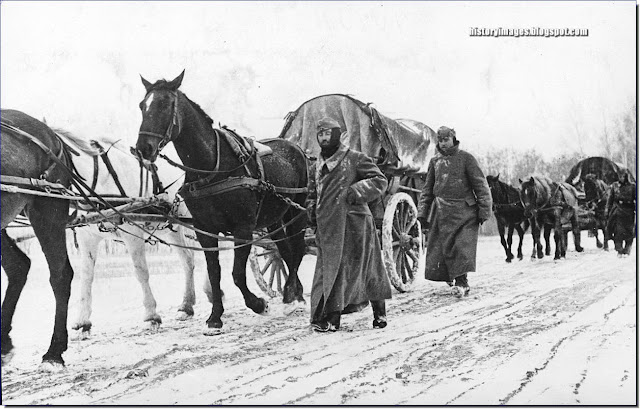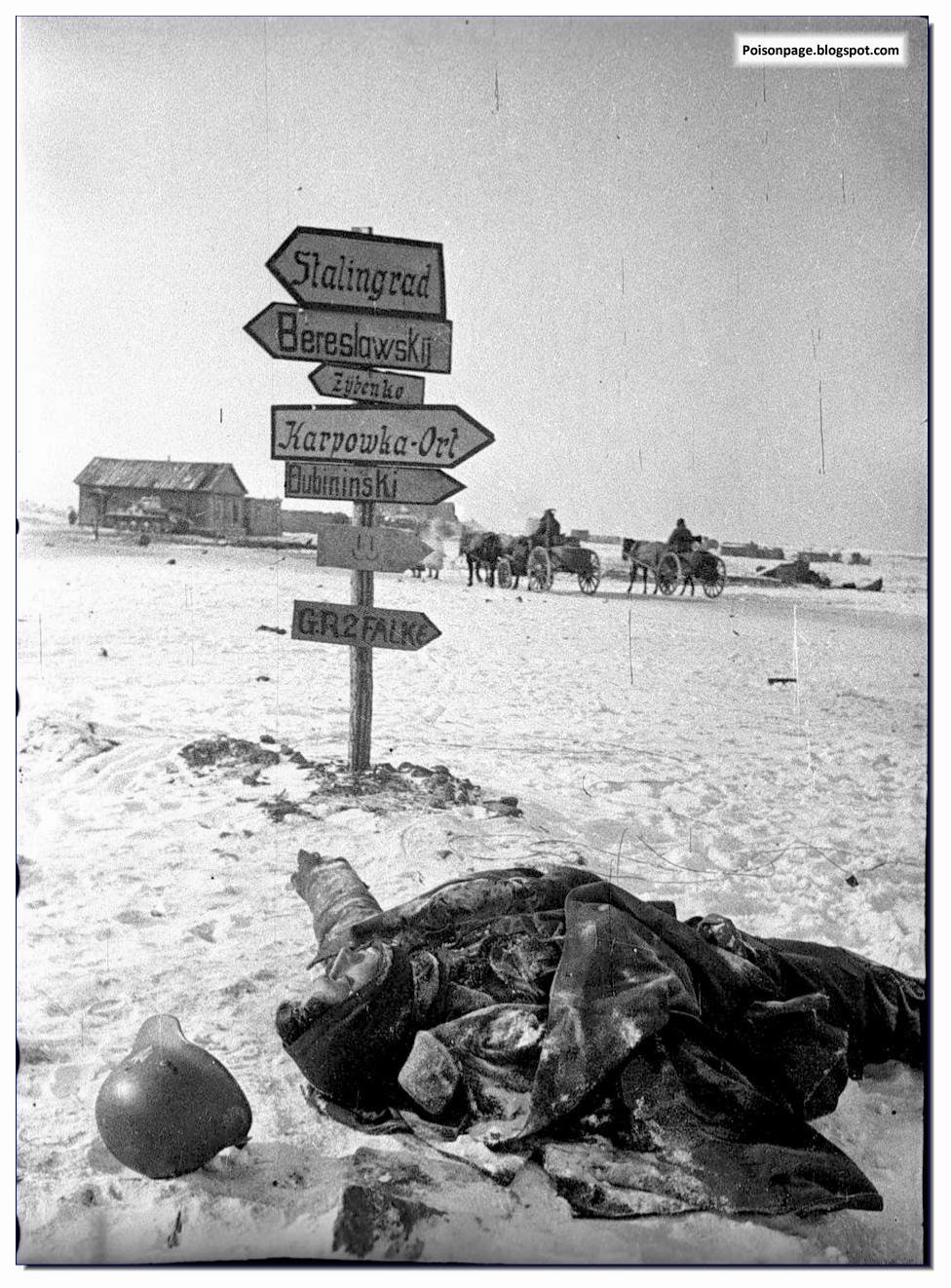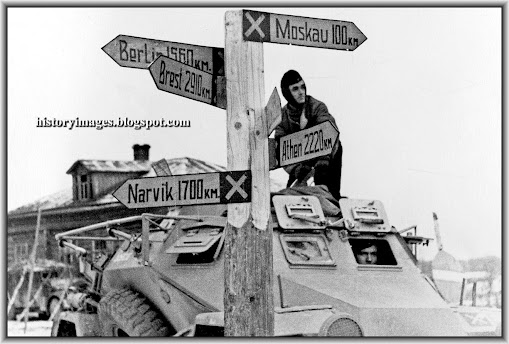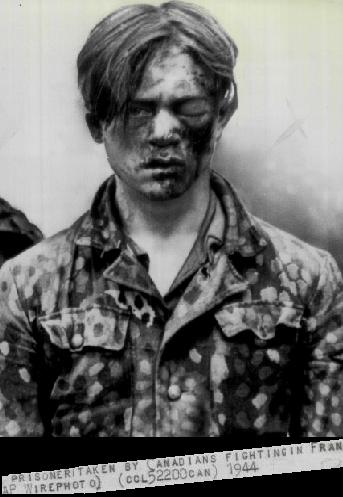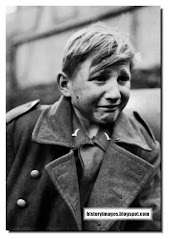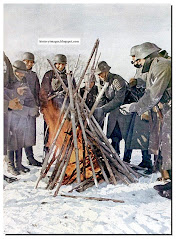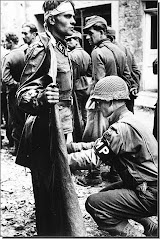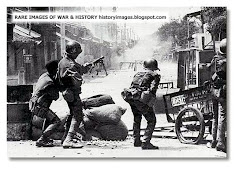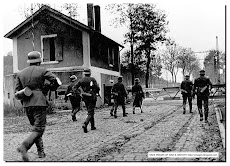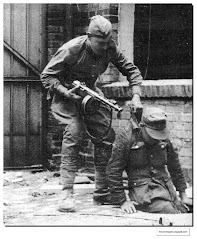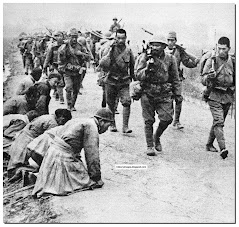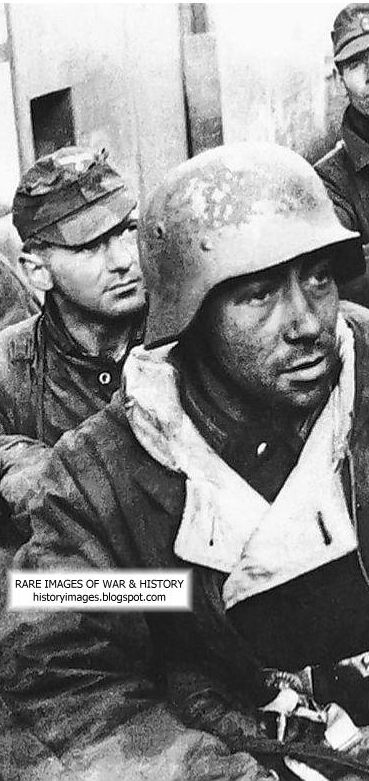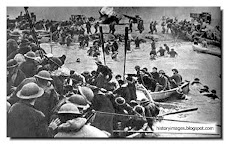A South Vietnamese soldier handles a corpse. 1966 (Image by Christian Simonpietri)
These men were soldiers. They were unfortunate. They fought for a country that ceased to exist, gobbled up by a aggressive brethren. They fought for a regime that was dictatorial and unpopular.
When America dumped South Vietnam and the communist North took over, no one shed any tears for these men of the ARVN (also called SVA- South Vietnamese Army). They lived and live in disgrace in Vietnam.
Their situation is not dissimilar to the soldiers of Waffen SS. Only that the world forgot soldiers of a country called South Vietnam.
A South Vietnamese soldier with a American made M 16 rifle
South Vietnamese soldiers with arms seized from the North Vietnamese (NVA) soldiers
SVA soldiers with flags captured from the communist NVA
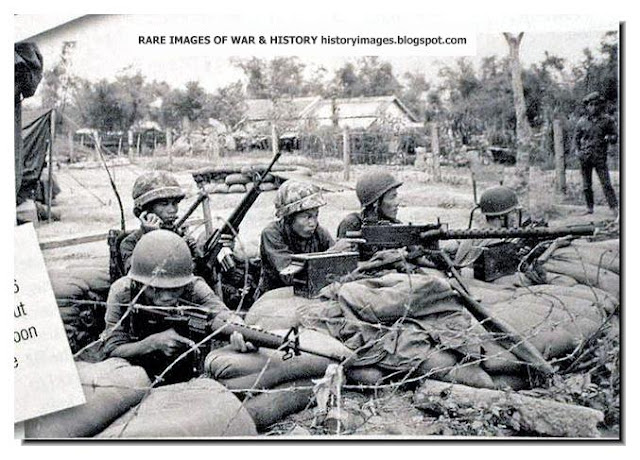 |
| South Vietnamese soldiers defend a village during the Tet Offensive |
 |
| South Vietnamese soldiers fighting on the streets of Saigon during the Tet Offensive in 1968.
|
 |
| A SVA soldiers takes an injured villager to safety. The regime was lousy but the SVA men came from the country and loved it |
 |
"Liberation" of Hue on Chinese New Year 1968 by by the NVA. Thousands of people, army, ARVN officers, the clergy. Catholics in Hue were killed, or buried alive.
BATTLE OF HUE
The Battle of Huế during 1968, was one of the bloodiest and longest battles of the Vietnam War (1959–1975). The Army of the Republic of Vietnam and three understrength U.S. Marine Corps battalions attacked and defeated more than 10,000 entrenched People's Army of Vietnam (PAVN) and National Front for the Liberation of South Vietnam (NLF, also known as, Viet Cong) guerrilla forces.
With the beginning of the Tet Offensive on January 30, 1968, the Vietnamese lunar New Year, large conventional American forces had been committed to combat upon Vietnamese soil for almost three years. Highway One passed through Hué and over the Perfume River (the river ran through the city dividing it into both northern and southern areas) creating an important supply line from the coastal city of Da Nang to the DMZ for the Allied forces. Hué was also a base for United States Navy supply boats.
The city, considering its value and its distance from the DMZ (only 50 kilometres (31 mi)), should have been well-defended, fortified, and prepared for any communist attack.
However, the city had few fortifications and was poorly defended. The South Vietnamese Army and U.S. Army forces were completely unprepared when the North Vietnamese army and Viet Cong failed to observe the promised Tet Truce. Instead, the Viet Cong and the North Vietnamese Army launched a massive assault throughout South Vietnam, attacking hundreds of military targets and population centers across the country, among them the city of Hué.
The North Vietnamese forces rapidly occupied most of the city. Over the next month they were gradually driven out during intense house-to-house fighting led by the Marines. In the end, although the Allies declared a military victory, the city of Hue was virtually destroyed and more than 5000 civilians were killed, more of them executed by the PAVN and Viet Cong (according to the South Vietnamese government). The North Vietnamese forces lost an estimated 2,400 to 8,000 killed, while Allied forces lost 663 dead and 3,707 wounded.
The tremendous losses negatively affected the American public's perception of the war and political support for the war began to wane.
|

Street in Saigon. 1968. South Vietnamese soldiers during the Tet Offensive.
Tan Son Nhut Air Base (1955–1975) was a Republic of Vietnam Air Force (VNAF) facility. It is located near the city of Saigon in southern Vietnam. The United States used it as a major base during the Vietnam War (1959–1975), stationing Army, Air Force, Navy, and Marine units there. Following the Fall of Saigon it was taken over as a Vietnam People's Air Force (VPAF) facility and remains in active use today.
SVA soldiers pass the corpses of Vietnamese people killed by the communists.
A SVA soldier looks after a wounded woman during the Tet Offensive
SVA soldiers with captured Vietcong. Propaganda? May be.
Former SVA men now POW escorted by a North Vietnamese soldier
THE FATE OF THE UNFORTUNATE SOLDIERS OF SOUTH VIETNAM
Once proud soldiers, they lived in utter poverty and disgrace under the new dispensation. They were soldiers. They were our allies against communism. They deserved better. They deserve the same respect as a American Vietnam Veteran.
German infantrymen watch enemy movements from their trenches shortly before an advance inside Soviet territory, on July 10, 1941. (AP Photo)
Operation Barbarossa began on June 22, 1941. German troops crossed the Russian border. The wily Stalin was caught unawares. He did not expect Hitler to attack so early. Stalin had disregarded intelligence inputs and advice from many Russian officers to be wary of Germany.
Hitler had expected Communist Russia to collapse like a pack of cards. For the first six months it seemed he was right as the German juggernaut rolled on into the Soviet Union.
The turning point came as the Germans reached the outskirts of Moscow. Nature stepped in. The harsh winter set in. The Greece adventure in May 1941 had delayed Barbarossa's start. The stretched German supplies wore thin. And Stalin showed his true nature. The Russian spine stiffened. Mother Russia's call was answered.
Fresh troops from eastern Russia were sent in and the German advance stalled. Barbarossa had failed. Russia did not surrender.
Here are some images of Operation Barbarossa.
A German infantryman walks toward the body of a killed Soviet soldier and a burning BT-7 light tank in the southern Soviet Union in in 1941, during the early days of Operation Barbarossa. (Deutsches Bundesarchiv/German Federal Archive)
This is how the New York Times reported on June 22,
This war is not an ordinary war. It is the war of the entire Russian people. Not only to eliminate the danger hanging over our heads, but to aid all people groaning under the yoke of Fascism .
Josef Stalin - 22nd June 1941
Operation Barbarossa: Invasion of Russia. June 22, 2012 to August 25, 1941. CLICK TO ENLARGE MAP
Stuka Dive Bombers (Ju 87) fly over Russia. November 7, 1941. (AP Photo)
The Russian colossus...has been underestimated by us...whenever a dozen divisions are destroyed the Russians replace them with another dozen.
General Franz Halder - Army Chief of Staff - August 1941
August 1941. A German peers through a peep hole as he sits in a tank (Deutsches Bundesarchiv/German Federal Archive)
German soldiers cross the Don river in a sturmboat
 |
| Germans in October 1941, near Salla on Kola Peninsula, a Soviet-occupied region in northeast Finland. (AP Photo) |
 |
| A German soldier stands guard as a bridge over River Dneiper burns in Kiev, Ukraine |
 |
| Germans crouching in position are about to attack the city of Kiev. 1941 |
 |
| Russian soldiers wait for the German attack (LOC) |
 |
| Scorched earth policy by the Russians. Burn everything as you retreat. Leave nothing for the enemy. A Leningrad suburb. October 21, 1941. Russian inhabitants try to save anything they can. (AP Photo) |
 |
| July 2, 1941. Russian POW walk back to the German lines as German assault troops march to the front. (AP) |
 |
| Heinrich Himmler visits a camp for Soviet POW (National Archives) |
 |
Millions of Soviet soldiers surrendered during the early stages of invasion of Russia. They were cruelly treated and left to starve. (AP Photo)
Hitler with von Brauchitsch (Commander -in-chief of the German Army) and General Halder (Chief of Staff) pore over the maps on August 7, 1941 to see how the Ostfront was doing.
June 26, 1941. German soldiers move through a Russian village as it burns
Russian civilians about to be hanged by the Germans. September 1941. Smolensk region.
General Heinz Guderian with his men in Russia. September 1941. If only Hitler had listened to Guderian and Manstein more......
German soldiers move through a Leningrad suburb as it burns. November 1941. Hitler lost interest in Leningrad (he was looking at Moscow) and made a siege of the city. If the Germans had made a full blooded attack, Leningrad would have fallen
Frost-bitten and weary German soldiers near Moscow. November 1941
November 22, 1941. Germans enter Rostov after some very bloody fighting.
Germans interrogate a downcast Russian soldier. October 1941
Germans with Russian POW August 1941. Russian POW were very brutally treated and starved.
Russian POW sent to Germany in freight trains for forced labor.. October 1941
Germans round out Russian snipers. August 1941
August 1941. German soldiers enter the burning city of Smolensk.
November 21, 1941. Germans enter Stariza which was torched by the retreating Russians |
Popular Articles On This Site
-
The German women raped and forced into sexual slavery at the end of WW2 are still among the most forgotten, suppressed, ridiculed vi...
-
As the 1945 began, the Russian army inexorably began to close into Germany. The result was foregone. But for the Nazi regime and the Ger...
-
Guido Knopp, sums the Waffen-SS perfectly in his documentary “Waffen SS – Hitler’s Elite Fighting Force”: “Had that marvellous courage ...
-
As described by both Churchill and Elliott Roosevelt in their memoirs, "Stalin rose and proposed a blood-curdling toast. The streng...
-
In the years 1945 to 1946 Germany was a collection of denouncers, black-marketeers, prisoners, refugees from justice and tireless whingers....
-
Two Waffen SS soldiers have a drink. In the background burns a T-34 tank Boys will be boys! SS troops welcomed by Ukrainian g...
-
Wounded German soldiers near Minsk, Belarus. 1944. It was a painful process. The once mighty Wehrmacht was slowly disintegrating. It ...
-
Berlin. April 1945. Apocalypse. Hell on Earth. This savage battle on this ancient cultured city is perhaps one of the most brutal battl...
Points To Ponder
WHY WAS THE FIGHTING ON THE RUSSIAN FRONT SO FIERCE DURING WW2?
It is difficult to distinguish between the quality of both the German and Russian soldiers. Both were motivated by their love for their motherland. But there were others factors that drove the two sides to such desperate fighting.
One, both sides knew that this was a no-holds bar war. Not fighting was thus not an option.
Second, both Hitler and Stalin had squads that killed any deserter. Turning away from fighting was just not possible.
Thus was seen some of the most bitter, brutal and desperate fighting on the WW2 eastern (Russian) Front.
"Those who do not remember the past are condemned to repeat it."
-- George Santayana
Quotes....
"Be polite; write diplomatically; even in a declaration of war one observes the rules of politeness."
--Otto von Bismarck
"When the enemy advances, withdraw; when he stops, harass; when he tires, strike; when he retreats, pursue.'
--Mao Zedong
Quotes....
"The main thing is to make history, not to write it."
--Otto von Bismarck
"When you have to kill a man it costs nothing to be polite."
--Winston Churchill
Quotes....
"In time of war the loudest patriots are the greatest profiteers."
--August Bebel
"God is not on the side of the big battalions, but on the side of those who shoot best."
--Voltaire
Quotes about War....
"Anyone who has ever looked into the glazed eyes of a soldier dying on the battlefield will think hard before starting a war."
---Otto von Bismarck
Quotes....
"Naturally the common people don't want war; neither in Russia, nor in England, nor in America, nor in Germany. That is understood. But after all, it is the leaders of the country who determine policy, and it is always a simple matter to drag the people along, whether it is a democracy, or a fascist dictatorship, or a parliament, or a communist dictatorship. Voice or no voice, the people can always be brought to the bidding of the leaders. That is easy. All you have to do is to tell them they are being attacked, and denounce the pacifists for lack of patriotism and exposing the country to danger. It works the same in any country."
--Hermann Goering
Quotes....
"To conquer the enemy without resorting to war is the most desirable. The highest form of generalship is to conquer the enemy by strategy."
--Tzu Sun
"All men are brothers, like the seas throughout the world; So why do winds and waves clash so fiercely everywhere?"
--Emperor Hirohito





















































